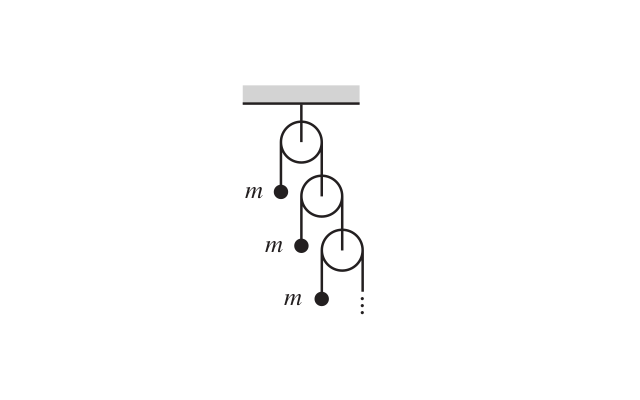The Infinite Atwood Machine
Consider the infinite Atwood’s machine shown in the figure.

A string passes over each pulley, with one end attached to a mass and the other end attached to another pulley. All the masses are equal to m, and all the pulleys and strings are massless. The masses are held fixed and then simultaneously released. What is the acceleration of the top mass?
I have given the problem statement as it is. My humble request is for you all to help me obtain a mathematical solution to the above question rather than a trivial physical interpretation. Cheers!
No vote yet
1 vote
Easy Math Editor
This discussion board is a place to discuss our Daily Challenges and the math and science related to those challenges. Explanations are more than just a solution — they should explain the steps and thinking strategies that you used to obtain the solution. Comments should further the discussion of math and science.
When posting on Brilliant:
*italics*or_italics_**bold**or__bold__paragraph 1
paragraph 2
[example link](https://brilliant.org)> This is a quote# I indented these lines # 4 spaces, and now they show # up as a code block. print "hello world"\(...\)or\[...\]to ensure proper formatting.2 \times 32^{34}a_{i-1}\frac{2}{3}\sqrt{2}\sum_{i=1}^3\sin \theta\boxed{123}Comments
Call the topmost block as Block0, the next block as Block1 and so on.
Let ai denote the acceleration (in the downward direction) of Blocki for i=0,1,2….
Then, by the principle of virtual work, we have: i=0∑∞2iai=0
By Newton's second law, mg−2iT=maii=0,1,2… Where T is the tension in the string connecting Block0.
Now, plugging in the value of ai (from the second equation), into the first one, and some simplification, we get T=23mg
Hence, a0=−2g
Where can I read about principle of virtual work? Btw , very nice & smart sol.n !,+1! @Deeparaj Bhat
Log in to reply
I think the general notion of conservation of string is termed as principle of virtual work by some other concept of energy conservation, maybe? Am I right @Deeparaj Bhat ?
Log in to reply
I believe in the latter. It is more commonly used than conplex words like "virtual work". Virtual work is nice but in real life it does not really apply because no machine is 100% efficient. Conservation of energy is better because it even covers dissipated energy.
Actually, the principle of virtual work is far more general. In fact, it's in the heart of Lagrangian mechanics.
But, no, it's not really very related to energy conservation.
Log in to reply
Yeah, but I have used the latter term often.
yeah!! its more related to least action
i take it that u are invoking D'Alembert's form of the principle???
Log in to reply
Yeah.
Why do you know lagrangian mechanics?:p
Log in to reply
lol
i found this book by H.Goldstein in the basavangudi library which started with lagrangians and hamiltonian
Log in to reply
Oh I'm reading that book as well. What a pleasant coincidence. Is it the one that starts with the mechanics of a single particle and then goes on to systems of particles and stuff?
Log in to reply
That book was put in general by Julien in slack.
Log in to reply
yes i know. that's how i got it...
Log in to reply
Same here.
yes :)
But isn't the basis for Lagrangian mechanics that Euler Lagrangian formula for energy or whatever. That is why I assumed that it had to do with energy
Log in to reply
It more or less comes to that. But, it kicks off with virtual work. After a lot of simplification (and assumptions), you get the form that you're talking about.
Log in to reply
ok thanks anyways. I am new to Lagrangian mechanics and hope I will master it soon. :)
Are you all college guys!!
Log in to reply
Nah I am in 11th :P
Just finished 12th :P
Hope so. @Swapnil Das , @Ashish Siva please comment.!
Log in to reply
Yes both are there.
Umm. Kind of a mixture of both.
See this problem
I learnt from an old book of my dad's.
I don't know any good resource.
Can someone please provide a link to virtual work mechanics?
Log in to reply
It is total work done is 0 in a fancy way
SUM Ti ai = 0